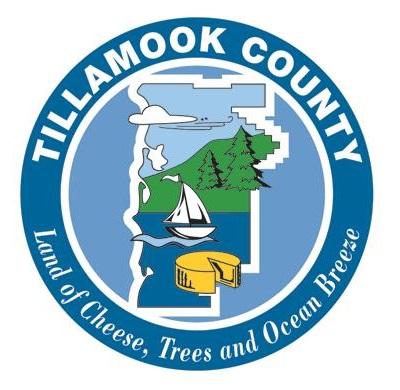Emergency Mangement
Mission Statement
To maintain an Emergency Services system as defined in ORS 401, by planning, preparing and providing for the prevention, mitigation and/or management of emergencies or disasters that present a threat to the lives and property of the citizens of Tillamook County.
Tillamook County Flooding Advisory and Road Closure Updated
AS OF 1:00 pm 12/23/25
Roads recently opened
*Trask River Road has 1 lane open at Mile Post 5. Drive with caution
Roads currently closed
*Wilson River Loop Road has been close, from FredMeyers (Highway 101) and the Sollie-Smith Road.due the river bank erosion which is threatening the integrity of the roadway.. Please use Latimer Road as a detour.
Roads open but have standing water on them
Tillamook County emergency officials are advising residents to use caution as flooding continues to affect multiple areas throughout the county.
Drivers are urged to slow down, remain alert for debris, and never drive through standing water. Motorists must not bypass or drive around road closure signs, as doing so places both the driver and first responders at risk.
Residents should be prepared for potential power outages associated with ongoing severe weather conditions. Officials also encourage the public to report flooding, downed trees, or other hazards to local authorities.
Public works crews and emergency responders are actively monitoring conditions and will reopen routes as soon as they are safe.
For those who would like to obtain sandbags, the Tillamook County Public Works Department has stockpiled sand and empty bags outside their North Gate. You will need to bring your own shovel to fill. Please be considerate and only take what you need, so others will be able to secure some for their needs.
Help Us Prepare for Emergencies in Tillamook County!
Tillamook County Emergency Management is compiling a confidential contact list of individuals with equipment, supplies, or resources that could be available for use during local disasters. This list will be used exclusively by Emergency Management personnel and will not be shared publicly.
If you are willing to participate, please complete the survey in full. Your support will help strengthen Tillamook County’s resilience and readiness in times of need.
Thank you for your commitment to our community!
https://forms.gle/qhdqxJuAqGxm1Dd49
Tsunami Evacuation Drill with the Great Oregon Shakeout on October 16, 2025 AT 10:16 AM this year.
What You Can Do to Stay Safe and Prepared:
- Know your evacuation routes: Whether you’re at home, work, or visiting the coast, familiarize yourself with local tsunami evacuation routes. Maps are often posted in coastal areas or can be found online using the DOGAMI/NANOOS Tsunami Evacuation Zones portal.
- Sign up for emergency alerts: Stay informed by subscribing to alerts at ORalert.gov for emergency notifications tied to your zip code—including earthquake and tsunami alerts. And turn on the Wireless Emergency Alerts (WEA) on your phone, so you will receive alerts based on where your phone is located (important if you are visiting the coast).
- Create a go kit: Prepare a portable emergency kit with essentials such as food, water, medications, and personal documents.
- Review your emergency plan: Ensure everyone in your household knows what to do during an earthquake or tsunami, including where to meet and how to communicate if separated. You can learn more about emergency planning with the free Be2WeeksReady Toolkit.
For Travelers:
• Check Travel Conditions: If traveling, visit www.tripcheck.com for real-time road conditions in Oregon.
• Neighboring States: If your travel extends to California or Washington, check their Department of Transportation websites for updates:
Travel | Caltrans, Travel Center Map | WSDOT.
DOGAMI encourages coastal residents and visitors to use this event as a reminder to stay informed about tsunami hazards and to practice evacuation drills regularly. DOGAMI provides additional information about tsunami preparedness at the Oregon Tsunami Clearinghouse OPRD recommends exploring Oregon’s beautiful coast safely by always being prepared for emergencies.
For more information about earthquake and tsunami preparation, visit Tsunami Safety.
If you do not have ShakeAlert on your phones, I suggest that you check out it out.
- The MyShakeTM app was developed by the UC Berkeley and is sponsored by the California Governor’s Office of Emergency Services. MyShake is available for free in the Apple iTunes and Google Play stores – more information is available here. MyShake is currently operating in California, Oregon, and Washington.
How do I sign up for the ShakeAlert® Earthquake Early Warning System?
|
MyShakeTM |
Mobile App |
Apple Store and Google Play |
MyShake For CA/ORWA |
CA/OR/WA |
Hopefully this information will help you become better prepared, please pass along to all you know that live along the west coast.
BE PREPARDED NOT SCARED
Emergency Alert Notifications
Sign up to be alerted about emergencies
On the Road
Make sure your vehicle is in good working condition before you travel.
Keep your gas tank as full as you can. A full tank will also keep the fuel line from freezing.
Install good winter tires and make sure they have enough tread, or any chains or studs required in your local area.
When driving, increase your following distance from 3-4 seconds to 5-6 seconds. It takes longer to slow down and stop on icy roads.
Every vehicle should have an emergency supply kit in the trunk. Kits should be checked every six months and expired items should be replaced regularly.
Keep family and emergency phone numbers, including your auto insurance provider and a towing company in your phone.
Consider keeping a power bank for your phone in your car in case your car loses power.
If stranded, run the engine for about 10 minutes per hour to run the heater and charge your cellphone. Open a window slightly to let fresh air in and avoid carbon monoxide (CO) poisoning.
TSUNAMI & HAZARD AREA MAPS
|
|


